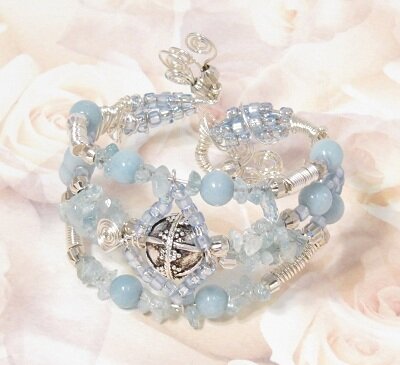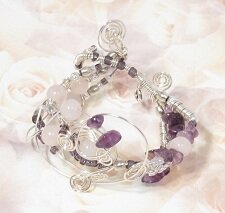|
Contact the seller in advance before paying for the order! Jewelry Wire
Jewelry wire is one strand of metal and is not the same as beading wire which is made of several strands. The wire is an old invention, and was made already 2000 BC. It was not made like jewelry wire is made today, but by hammering metal flat, twisting it and then roll it into a tube. The spiral pattern was then visible at each end of the wire.
Today wire is made with the ancestor of a Roman method where metal is drawn through a plate with holes. The holes are of different sizes and determines the diameter/gauge of the jewelry wire. The round shape was for decades the only shape a wire could be made in. Today, however you have several more shapes to choose from as you can get round, half round, square and twisted wire. Jewelry wire has been, and is, made for several purposes and jewelry making is one of them. Wire wrapping is a popular jewelry technique where something, most often a cabochon is wrapped in wire, sculpted into soft curves, spirals and twists. Wire is also used to make jump rings, head and eye pins, ear wires, clasps and chains. A Wire-jig makes it easy to create clasps, links and other shapes formed with wire as you have lots of pegs that you can place in a tray with holes. This way you can create a pattern by bending the wire around the pegs to shape it. Jewelry wire has for millenniums been used to make rings for Chain mail. Chain mail was made by connecting several rings into a mesh and was used as protection from weapons during war fare. Today Chain mail is mainly used for jewelry, although some still make armor for different purposes than war, like costumes. Jewelry chains are made from several wire rings shaped and soldered together into chains. So you see, this is an extreme versatile component of jewelry making. You can even melt the left overs and make something else out of that. Wire sizes: An other system that was used earlier was known as Standard Wire Gauge (SWG). This system was also called Imperial wire gauge or British standard gauge. It is not much used today, except for measuring guitar strings and electrical wire. The other way of measuring the diameter today, is the European, where millimeters are used instead of gauge. Since I live in Norway I am most familiar with this type of measurement. Sometimes it is a bit confusing though, since most information on internet about wire is measured by gauge. So, sometimes you need a converter. And here it is.
Most beads have holes of approximately 1 mm in which a 20 gauge/0,8 mm jewelry wire will fit. Pearls and gemstones sometimes have smaller holes and fits a higher gauge jewelry wire like 22-26. Which gauge you should use for your projects depends on what you are making. If you are not bound by the hole size in the beads you use, you can use wires with different gauges in the same project to create stunning effects.
If you make jump rings for chain mail, you have to take the thickness of the jewelry wire into consideration, not just the inside diameter of the rings. The inside diameter of the rings must be able to fit the wire up to several times, depending on the pattern you use. There is of course a formula for this, where you take the inner diameter of the ring and divide it with the wire diameter, which gives you the aspect ratio. AR=ID/WD. You can read more about that in the Chain mail section. I mostly use 20 gauge jewelry wire for my projects. I find that it fits most beads and is easy to handle and manipulate. I also use 22 gauge for pearls and gemstones with small holes. Thicker wires gives a more solid appearance, so choose wire according to what you want to make. Try them out so that you know exactly how they look and how they feel to work with. Thicker wires are harder to work with than thinner regardless of the hardness, which brings us to the next chapter. Dead soft wire is drawn through the correct sized diamond or carbon die of the machine (that is the plate) only one time. The wire is very soft and malleable, and can easy be bent with your hands/pliers. Dead soft wire is used mainly for wire wrapping. It will not hold its shape when stressed, and is not suitable for jump rings, eye- and head pins, or any other ting where it is important to maintain shape. Half hard wire is drawn through the die 2 times. The wire is still malleable, but keeps its shape better. It can be used for jump rings, eye-and head pins, and also for wire wrapping and other things that must stay in shape. It is the most suitable hardness for jewelry making. Hard wire is drawn through the die up to 4 times, and holds shape very nicely. It is however tougher to deal with and tends to spring back if you try to shape it. You can use it for anything where you need a wire that will hold shape even when put under stress. Spring hard wire is drawn through the die 8 times and is difficult to shape. It is not suitable for jewelry making, unless used as memory wire that is pre coiled. A wire with a lower gauge is harder dead soft than a dead soft higher gauge wire, like I mentioned earlier. (lower gauge = thicker wire, remember?) The hardness of a wire can be changed by annealing or heating it. This will change the molecule structure in the metal and it will restore the elasticity. On the other side, a dead soft wire will toughen if bent a lot, and may become brittle and brake when handled to much.
A lot of people have Nickel allergy, which causes the skin to get irritated and sore when they wear cheaper jewelry that is plated with silver or gold, instead of the more expensive solid gold and silver. This is a thing to keep in mind when you make jewelry, and perhaps inform your customers about it if you use silver and gold plated wire, clasps, links etc.
Silver, silver plated, copper and brass wire will tarnish over time. In it self this is no problem, since there are several cleaning solutions available to remove the tarnish and make them shiny again. The difficulties appear when you have mixed wire with pearls, gemstones or other beads that will be ruined during the cleaning process. But, despair not! You can get anti tarnish paper strips which will prevent the metal from tarnishing. If you keep the wire or the jewelry in a zippered plastic bag and add a strip of anti tarnish paper, they will remain shiny. You can get wire in different colors beyond the metals true color. Color coated Aluminum wire is very soft and comes in a lot of colors. The wire is very prone to scratches in the coating and must be treated a bit carefully. It helps to dip your pliers in a rubber coating, so they can't mark the wire during handling it. Niobium wire is another colored wire that you can get half hard in a huge variety of colors. So, you see wire comes in all types of metals, alloys, gauges, shapes and hardness. So you have lots to choose among. If you are unfamiliar with wire, I would recommend you to practice on cheaper wire, until you know how they feel to your hands and how they behave when you try to manipulate them. Don't get frustrated, take your time. Working with wire is very rewarding, so practice practice, practice at a slow pace. Return from Jewelry Wire to Jewelry Basics Leave a comment ,I would love to hear your opinion on this page. Good or bad, it will help me making this Site better. |
|||||||||||||||||||||||||||||||||||||||
Loans for US Residents:
Choose what you need:
Jewelry and polymer clay tutorial heaven

Promote Your Page Too

 About metals:
About metals:
